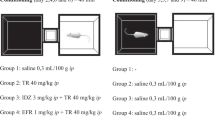Abstract
Drug interactions in reinforcing effects of over-the-counter cough syrups were investigated by utilizing place preference conditioning in rats. Dihydrocodeine (2 mg/kg, IP) induced a small, non-significant place preference. On the other hand, concurrent dosing of dihydrocodeine (2 mg/kg, IP) and a mixture (SC) of methylephedrine (4 mg/kg), caffeine (4 mg/kg) and chlorpheniramine (0.8 mg/kg) produced a significant place preference, the mean conditioning score in this group being about 3 times higher than that in the dihydrocodeine alone group. The potentiation of dihydrocodeine-conditioned place preference was observed by combination with chlorpheniramine (0.8 mg/kg, SC) alone as well as with the mixture, but neither with methylephedrine (4 mg/kg, SC) nor with caffeine (4 mg/kg, SC). Chronic infusion of the dopamine D1 receptor antagonist SCH23390 (1.0 mg/kg/day, SC) during conditioning abolished the appetitive effects of dihydrocodeine combined with chlorpheniramine. In conclusion, it is suggested that the potentiation of appetitive effects of dihydrocodeine is mostly due to chlorpheniramine among three ingredients in the cough syrups, and that the dopaminergic system, especially D1 receptor, may play an important role in the potentiation effect of chlorpheniramine on the reinforcing effects of dihydrocodeine.
Similar content being viewed by others
References
Bergman J, Spealman RD (1986) Some behavioral effects of histamine H1 antagonists in squirrel monkey. J Pharmacol Exp Ther 239:104–110
Evans SM, Johanson CE (1989) Discriminative stimulus properties of histamine H1-antagonists in animals trained to discriminated-amphetamine or pentobarbital. J Pharmacol Exp Ther 250:779–786
Hemmi T (1969) How we have handled the problem of drug abuse in Japan. In: Sjoqvist E, Tottie M, Almqvist J (eds) Abuse of central stimulants. Wisksell, Stockholm
Hemmi T (1974) Socio-psychiatric study of drug abuse in Japan. Excepta Medica, ICS, No 274
Kase Y, Ikegami K, Kito G, Oyama Y, Takahama K, Miyata T, Kubo S (1978) Changes in antitussive and other pharmacological effects of dihydrocodeine due to combination with chlorpheniramine and methylephedrine. Pharmacometrics 15:403–418
Mucha RF, Herz A (1985) Motivational properties of kappa and mu-opioid receptor agonists studied with place and taste preference conditioning. Psychopharmacology 86:274–280
Mucha RF, Iversen SD (1984) Reinforcing properties of morphine and naloxone revealed by conditioned place preference: a procedual examination. Psychopharmacology 82:241–247
Shippenberg TS, Herz A (1987) Place preference conditioning reveals the involvement of D1-dopamine receptors in the motivational properties of μ- and κ-opioid agonists. Brain Res 436:169–172
Shippenberg TS, Bals-Kubik R, Herz A (1987) Motivational properties of opioids: evidence that an activation of δ-receptors mediate reinforcement processes. Brain Res 436:234–239
Spyraki C (1988) Drug reward studied by the use of place conditioning in rats. In: Lader M (ed) The psychopharmacology of addiction. Oxford University Press, Oxford, pp 97–114
Suzuki T, Yoshida E, Yoshii T, Koike Y, Misawa M, Yanaura S (1988) The effects of noscapine and chlorpheniramine on physical dependence and antitussive activity of dihydrocodeine. Jpn J Psychopharmacol 8:337–343
Tani N, Kaneko S, Minamikawa S, Miki H, Haga H (1984) A clinical study of SS-BRON solution-W dependency. Jpn J Alcohol Depend 19:205–210 (English abstract)
Ueyama K, Tominaga H, Matsumoto K, Nakae T (1984) A case of hallucinatory-paranoid state induced by chronic methylephedrine addition. Kyushu N-Psych 30:412–415 (English abstract)
Watanabe N, Sakai T, Tada K (1984) A case with manic-depressive state induced by brand ephedrine preparates. Clin Psychiatry 26:1120–1122 (in Japanese)
Author information
Authors and Affiliations
Rights and permissions
About this article
Cite this article
Suzuki, T., Masukawa, Y. & Misawa, M. Drug interactions in the reinforcing effects of over-the-counter cough syrups. Psychopharmacology 102, 438–442 (1990). https://doi.org/10.1007/BF02247122
Received:
Revised:
Issue Date:
DOI: https://doi.org/10.1007/BF02247122




